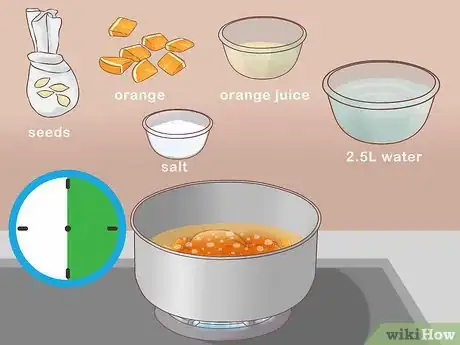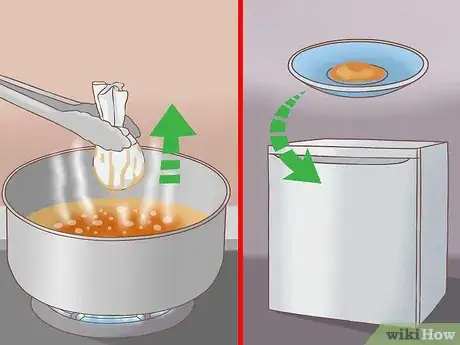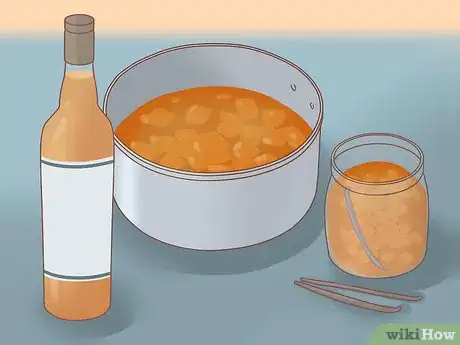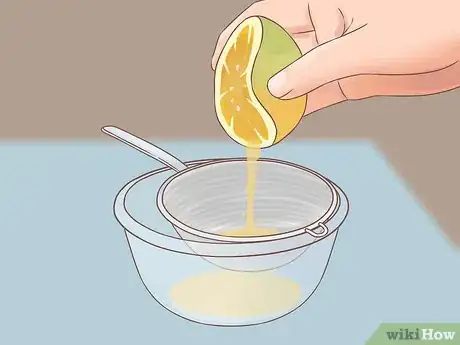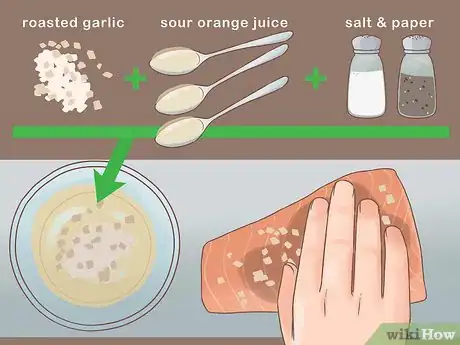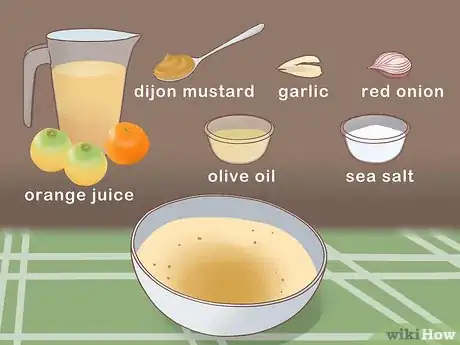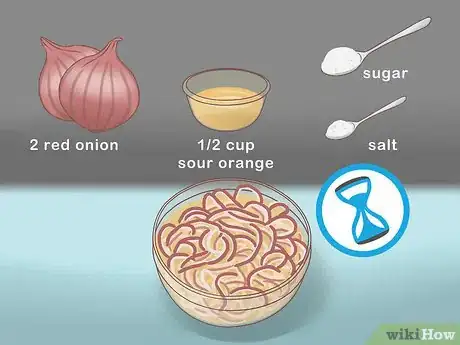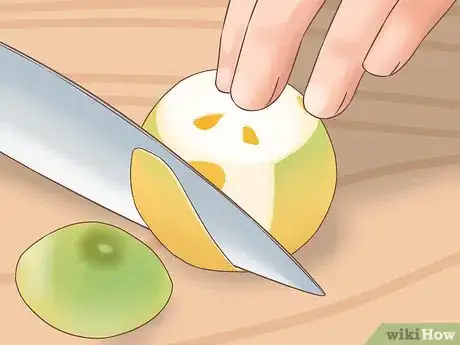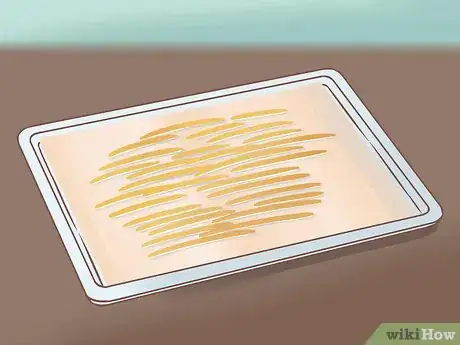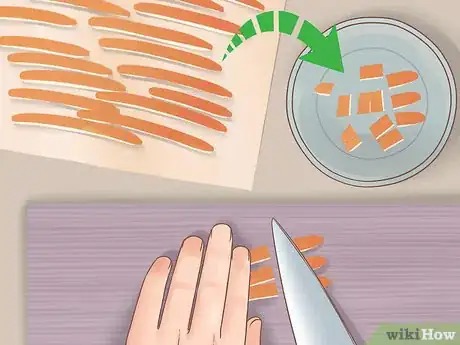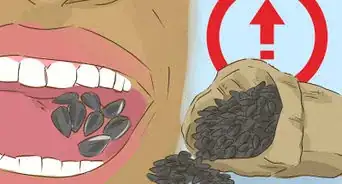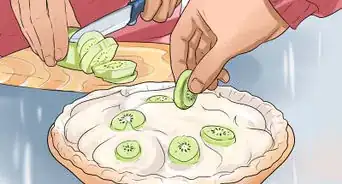This article was co-authored by wikiHow Staff. Our trained team of editors and researchers validate articles for accuracy and comprehensiveness. wikiHow's Content Management Team carefully monitors the work from our editorial staff to ensure that each article is backed by trusted research and meets our high quality standards.
There are 10 references cited in this article, which can be found at the bottom of the page.
This article has been viewed 38,932 times.
Learn more...
Sour orange is also referred to as bitter orange or Seville orange. This fruit isn’t typically eaten raw, since its natural state is too sour and has a bitter aftertaste. However, you can use sour oranges to make a tasty marmalade, tea, or juice. Experiment with a variety of uses for sour orange juice, such as in salad dressing or as a marinade. Make sure to wash your sour oranges and pat them dry before slicing or peeling them.
Ingredients
- 6 sour oranges
- 1 navel orange
- Water
- Salt
- 8 cups (1.6 kg) sugar
- 1 tablespoon Scotch (optional)
- Dried vanilla beans (optional)
Makes two quarts
Steps
Making Marmalade
-
1Cut each orange in half. Slice the oranges crosswise around the middle (not on the stem ends). Do this for the Seville oranges and navel orange.
-
2Separate the seeds from the fruit. Nestle a non-reactive mesh strainer into a bowl. Remove the orange’s seeds as you squeeze the oranges over the strainer. Tie the seeds securely in cheesecloth or muslin, and set the pouch aside.[1]
- Seeds are high in pectin, which will give your marmalade the texture of a rich jelly.
Advertisement -
3
-
4Boil the oranges. Add the orange pieces to a pot of water, and bring the water to a boil. Continue simmering until the oranges are cooked through. Drain the water out of the pot.[4]
- Certain sour orange varieties are more resistant to cooking. Pre-boiling the orange pieces ensures that they will be fully cooked.
- The oranges should be covered with water; an exact measurement is not needed.
-
5Cook the oranges and seeds in lightly salted water. Pour into the pot with the oranges 10 cups (2.5L) of water, the squeezed juice, and a pinch of salt. Add the pouch with the seeds in it to the pot. Bring the water to a boil over high heat, then reduce it to a simmer. Continue cooking for twenty to thirty minutes, or until the peels are translucent.[5]
- Once the peels are translucent, you can set the mixture aside overnight, if desired, to encourage the release of extra pectin.
-
6Boil the mixture with sugar. Stir 8 cups (1.6 kg) of sugar, then bring the mixture to a full boil. Reduce the heat so that the water maintains a gentle boil. Stir the mixture occasionally.[6]
- Occasional stirring prevents the bottom of the mixture from adhering to the bottom of the pot and burning.
-
7Remove the seed pouch and chill a saucer in the freezer. Place a saucer in the freezer. After twenty minutes of the mixture boiling, remove the seed pouch with tongs and discard the pouch. Allow the mixture to boil for about twenty more minutes, stirring occasionally.[7]
- Chilling a saucer will assist you with checking how well the mixture will gel.
-
8Check for doneness. Check the mixture with a candy thermometer for a jelling point of 220°F (104°C). With a cooking spoon, put a bit of the stirred mixture on your chilled saucer. Place the saucer back into the freezer. After a few minutes, observe whether the mixture is slightly jelled. If not, cook the mixture a bit longer until it gels properly.[8]
- After a few minutes in the freezer, the mixture should thicken somewhat, and wrinkle slightly to the touch.
- The saucer is just to test a small amount of the marmalade to verify that it’s finished cooking.
-
9Add Scotch and vanilla, if desired. Remove the pot from heat, and stir in the Scotch. Place a piece of vanilla bean into the bottom of sterile jars. Refrigerate or can your marmalade.[9]
Juicing Sour Oranges
-
1Extract the juice. Squeeze halved oranges over a bowl covered by a mesh strainer. Alternately, use a stationary or hand-held citrus squeezer to juice sour oranges. Discard the seeds caught by the mesh strainer.
-
2Make naranjada. For every four juiced oranges, mix in 1/4 cup sugar and 1½ cups water. Serve the juice ice-cold. Drink the juice plain, or mixed into a cocktail.[10]
- Naranjada is a popular South American beverage.
-
3Make a wet rub for meat or fish. Mix a finely chopped clove of roasted garlic with three tablespoons of sour orange juice. Add salt and pepper, to taste. Rub the mixture onto meat or fish before cooking.[11]
- For example, try this wet rub on grilled, baked or pan-fried fish.
-
4Make dressing. Use the juice when you want to make dressing.[12] Try making a salad dressing with the juice of two sour oranges and one regular orange, a tablespoon of Dijon mustard, a cup of olive oil, one crushed garlic clove, half of a small red onion (finely chopped), and sea salt, to taste.
-
5Pickle vegetables with the juice. For example, try pickling onions with sour orange juice. Add the pickled onions to gyros or tacos.[13]
- Boil and drain two large red onions (thinly sliced). Combine the onions with 1½ cups sour orange juice, a tablespoon of sugar and a teaspoon of salt. Allow it to sit for four hours, uncovered.[14]
Brewing Tea
-
1Peel the oranges. Remove the orange part of the peel only by carving it away with a chef’s knife. You may find it easiest to peel in large, long pieces. Avoid picking up the white pith as much as possible.[15]
- The white pith is bitter, thus you want to cut as much of the orange part only as you can.
-
2Arrange thin pieces of peel on a baking sheet. Use a large chopping knife, such as a Santoku knife. Cut the peel into long, thin strips. Lay parchment paper over the baking sheet before placing the peel down in a single layer.[16]
-
3Bake the peels. Warm your oven to a low setting, between 100 to 200 degrees Fahrenheit (38 to 93 degrees Celsius).[17] Keep the oven door cracked open, and check the peels frequently. Cook the peels until they stiffen and begin to curl.
- The peels can change from dry to burnt quickly, thus you need to keep a close eye on them.
- This process can take anywhere from twenty minutes to forty minutes or more.
- Alternately, you can dry the peels in a food dehydrator.
-
4Cool and chop the peels. Remove the tray from the oven and allow it to cool. Cut the peels down to small pieces that resemble loose-leaf tea.
- An exact size is not necessary; the peels may be finely or coarsely chopped.
-
5Submerge bagged tea in hot water. Boil water until it reaches 212°F (100°C).[18] Fill an empty tea bag or sachet with the dried, chopped peel. Steep the bag of sour orange in a cup of hot water for six to seven minutes.[19]
- Three cups of day daily, using one to two grams of dried peel, may soothe indigestion and heartburn by regulating stomach acidity.[20]
Things You'll Need
Making Marmalade
- Mesh strainer
- Bowl
- Cheesecloth or muslin
- Tongs
- Cooking spoon
- Chef’s knife
- 10-12 quart stockpot
- Saucer
- Wooden spoon
- Candy thermometer
- Canning jars
Brewing Tea
- Chef’s knife
- Santoku knife
- Baking sheet
- Parchment paper
- Pot
- Empty tea bag or sachet
- Cup
References
- ↑ http://www.davidlebovitz.com/seville-orange/
- ↑ http://www.davidlebovitz.com/seville-orange/
- ↑ http://www.davidlebovitz.com/seville-orange/
- ↑ http://www.davidlebovitz.com/seville-orange/
- ↑ http://www.davidlebovitz.com/seville-orange/
- ↑ http://www.davidlebovitz.com/seville-orange/
- ↑ http://en.julskitchen.com/preserves/bitter-orange-marmalade-and-nothing-else
- ↑ http://www.davidlebovitz.com/seville-orange/
- ↑ http://www.davidlebovitz.com/seville-orange/
- ↑ https://www.thekitchn.com/5-uses-for-sour-orange-juice-119172
- ↑ https://www.thekitchn.com/5-uses-for-sour-orange-juice-119172
- ↑ https://www.thekitchn.com/5-uses-for-sour-orange-juice-119172
- ↑ https://www.thekitchn.com/5-uses-for-sour-orange-juice-119172
- ↑ http://www.closetcooking.com/2011/11/mexican-pickled-red-onions.html
- ↑ http://www.thekitchn.com/how-i-make-dried-orange-peels-for-homemade-bitters-the-9bottle-bar-212236
- ↑ https://littlegreendot.com/how-to-make-dried-orange-peel/
- ↑ http://www.thekitchn.com/how-i-make-dried-orange-peels-for-homemade-bitters-the-9bottle-bar-212236
- ↑ http://theteaspot.com/how-to-brew.html
- ↑ http://theteaspot.com/loose-tea-vs-tea-bags.html
- ↑ http://www.uofmhealth.org/health-library/hn-3935005
- ↑ https://www.thekitchn.com/5-uses-for-sour-orange-juice-119172
- ↑ https://www.hort.purdue.edu/newcrop/morton/sour_orange.html




